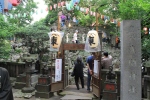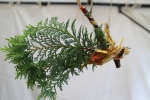Category Archives: festivals
Leave a comment | tags: Edo period pilgrimage, Fuji-ko, mini Fuji, mountain worship, 富士講, 富士塚, 山開き | posted in dragons, festivals, Fuji-san, Japanese religions, pilgrimage, Uncategorized
Shugendō 修験道 is a school of ascetic practice unique to Japan that centers around the mountains. So it would seem strange to find it in Shinagawa-ku of Tokyo. Yet the temple of Shinagawa-dera 品川寺 hosted several major shugen rituals, carried out by approximately thirty shugenja (practitioners of Shugendō), this past weekend. So does this mean that mountain-centered religious practices exist even in what is currently the largest metropolis in the world? Well, sort of.
The rituals at Shinagawa-dera this weekend—involving fire and boiling water—were historically performed by practitioners after long stretches of asceticism in the mountains. Through these periods of ritual seclusion, it was believed that they acquired special powers, which could then be used to benefit their followers. Under the regulations of shogun Tokugawa Ieyasu at the start of the Edo period (1600-1868), these practitioners—formerly itinerant—were forced to settle down in cities, towns, and villages across the country. As they did, they brought their practices and mountain connections to their new areas of residence. By performing impressive acts like walking across beds of hot coals or splashing boiling water around themselves, they showcased their powerful skills to gathered spectators, and as guides, began taking followers to famous mountain sites associated with Shugendō.
Such is likely the case with the temple of Shinagawa-dera. The temple has long been a branch temple of Daigoji 醍醐寺 (in Kyoto), which has served as the head temple of the Tōzan 当山 branch of Shugendō since the late sixteenth century. Through this connection, Tōzan shugenja likely brought their rituals to Shinagawa-dera. In turn, they would have been able to recruit and guide pilgrims to the distant Yoshino 吉野—famous among Japan’s numinous peaks and the main site of practice for Daigoji’s shugenja. So in this sense, Edo period shugenja not only brought their mountain culture to the city but then brought city dwellers to the mountains.
-

-
Preparing the saito goma 柴灯護摩 (the pile of pine branches about to be lit).
-

-
Smoke billowing from the saito goma. The goma fire ritual originated in India (“homa” in Sanskrit) and made its way across China before reaching Japan through Shingon Buddhism. While Shingon monks perform the ritual inside (in a goma-dō) though, it has traditionally always taken place outdoors in Shugendō.
-

-

-
A shugenja dousing water on the fire. Realistically, the pales of water he is using would have little impact in containing this fire. In symbolic terms though, shugenja were often thought to have special control over fire.
Just in case, a fire squad was on call behind the scenes.
-

-

-

-
A shugenja blowing the horagai 法螺貝, an instrument made out of a large conch shell.
-

-
Yudate 湯立て – a ritual in which water is boiled over flames before being sprayed about – in this case, with a pine branch.
-

-
With the flames from the saito goma now subsided, the ritual of hiwatari 火渡り, literally “crossing fire,” begins. Always done in bare feet, of course.
-

-

-
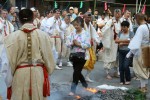
-
With all of the shugenja finished, anyone is free to walk through.
-

-

-

-
The line for hiwatari stretched out to the street.
-

-

-
Foot bathing afterwards.
-

-
The ending ceremony in front of the main temple of Shinagawa-dera.
2 Comments | tags: 火渡り, Daigoji, Edo period, 醍醐寺, hiwatari, mountain religion, saito goma, Shinagawa-dera, Shugendo, shugenja, tokugawa ieyasu, Tōzan, Yoshino, yudate, 吉野, 品川寺, 当山, 柴燈護摩, 湯立て, 修験道 | posted in festivals, Japanese religions, mountains, pilgrimage, Shugendo, Uncategorized
To members of my dissertation committee, the recent influx of matsuri entries on my blog might raise eyebrows (i.e., that I’ve gotten a bit sidetracked from my main research). Nevertheless, here’s another.
The shots below are taken from the Ōji Jinja Dengaku Mai 王子神社田楽舞, an annual festival in a northern section of Tokyo that centers on the dengaku dance. Dengaku is a performance with roots in Kyoto. As a form of kagura, it was historically intended to engage the deities, who descended into the bodies of the dancers through kamigakari 神懸かり (literally, “divine possession”). The performance thus encompassed the movements of the deities, whose presence brought blessings to both dancers and spectators. (For an excellent, in-depth study, see Irit Averbuch’s book, The Gods Come Dancing.)
Ōji literally means “prince,” and accordingly, the performers of the Ōji dengaku are boys and girls around the ages of 8-10. Children often occupied a liminal role in East Asian ritual (examples include Song period Daoism and Shugendo in Japan), in which they provided an interface between the spirit world and the human world. As a comparative, children in North American/European cultures have also often been imagined to dwell close to the spirit realm (just think of The Shining, The Exorcist, or The Sixth Sense).
In Shugendo especially, young gods known as dōji 童子 acted as divine messengers, attendants of powerful deities like Fudō myōō 不動明王, occupants of mandalized mountains, and protectors of practitioners during their time in the mountains. Ōji are in fact, a class of dōji originally from Kumano, thus suggesting a historical link between Kumano and the Ōji Shrine as well as the implied, divine nature of the dancers.
Dengaku and kagura 神楽 in general, nowadays, are no longer equated with acts of possession. However, the specific step sequences of the dances still reflect the original choreography. Moreover, the performances demonstrate how children continue to occupy a central role in many festivals throughout Japan.
(Click photos to enlarge.)
-

-
Preparation for a ritual space always involves some type of purification of the area. Here a menacing warrior steps to each corner (i.e. the four directions) of the stage, rams his bamboo shaft against the floor, and shouts off any bad spirits potentially lurking around the premise.
-

-
With the passage to the shrine (via the stage) now purified, the representatives of each of the affiliated neighborhood associations proceed to the shrine.
-

-
The messenger runs in a pair of straw-woven waraji 草鞋, commonly used in pilgrimage and ascetic practices.
-

-
With the arrival of important guests (i.e., the deities embodying the dancers), a messenger runs from the shrine to greet them. As a show of great respect toward them, he must run seven laps back and forth between the shrine and them (a procedure known as nana do han 七度半). Finally, they give approval and enter through the torii toward the shrine.
-

-
The messenger departing from the shrine. Behind him is the audience of shrine officials and affiliates awaiting the guests.
-

-
An ensemble of flutes and one taiko drum play as the dancers perform their first sequence down below the stage.
-

-
Two heavy duty warriors secure the path from any evil elements while the dancers performs.
-

-
A dancer performs the first sequence of dengaku below the main stage. There are twelve sequences in total but due to their length (two hours), they now perform several each year on a rotating basis.
-

-
The dancers climb the steps to the main stage, following a priest.
-

-
The sequence takes place on stage. The footsteps are the key component of the dance, varying with each sequence. Originally believed to represent the actions of the descended deity, each step further purifies the area by stomping out of the evil elements lying beneath.
-
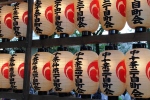
-
Lanterns representing each of the affiliated neighborhood associations (chōkai 町会) illuminate the stage.
-

-
Only post-ceremony–with the deities departed–can the dancers reveal their faces, this one beaming with pride.
-

5 Comments | tags: 王子, 王子神社, 田楽, 神懸かり, 神楽, 童子, dengaku, doji, Fudo myoo, Japanese religion, kagura, kamigakari, matsuri, Oji, possession, ritual, shamanism, Shinto, Shugendo, 修験道 | posted in festivals, Japanese religions, Shugendo, Uncategorized
The Hashiramatsu 柱松 (literally, ‘pine trunks’) is an event in which three columns of tied bamboo or pine branches are stood upright and lit on fire. The first to ignite determines the success (agricultural, economic, etc.) of the coming year. Traditionally coinciding with the first day of Obon, it may have also been believed to invite down the local deities and ancestral spirits residing in the mountains. The festival is held every three years at Togakushi and dates back to the late thirteenth century. Well okay, that chronology is a bit misleading.
In the wake of major alterations to religious institutions by the government in the early Meiji period, the Hashiramatsu ended in the 1870s. During this time, the three major temples on the mountain and their cloisters transformed from combinatory sites of Buddhism, Shinto and Shugendo into state-supported Shinto shrines. Shugendo itself was proscribed from mountain sites around the country, which helps to explain the disappearance of this shugen-influenced ritual from Togakushi.
But after a thorough investigation by local scholars of extant sources related to the Hashiramatsu at Togakushi as well as other mountains (where it has continued uninterrupted), the festival has been recently revived. Seeing the Togakushi Hashiramatsu offers a glimpse into the rich symbiosis of religious influences that were historically characteristic of practice at Togakushi and other sites around the country. It may also suggest the future direction of the culture at Togakushi Jinja, given the community’s increasing re-engagement with its vibrant past.
(Click on photos to open gallery mode.)
-

-
The three hashira, one for each shrine, arranged before the ritual. In keeping with one Edo period description, Chusha’s 中社 hashira is composed of bamboo, Hokosha’s 宝光社 is single branches, and Okusha’s 奥社 is a combination of the two. Lines with hanging white paper gohei 御幣 demarcate the inner ritual space, which must be fully purified of bad spirits (mamono 魔物) before the ritual takes place.
-
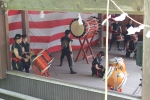
-
There were several performances preceding the Hashiramatsu. Here are the Togakushi Ninja Taiko players.
-

-
The Shishi Kagura 獅子神楽, performed by a group from Hokosha.
-

-
A third, dramatic taiko performance, performed as a solo by the visiting priest, Sekiguchi San.
-

-
A ritual procession from Chusha down to the hashira. A head priest leads.
-

-
Next in line are a group of visiting shugenja (practitioners of Shugendo) affiliated with Mt. Omine. They blow the horagai 法螺貝 as they approach.
-

-
Four miko 巫子 dancers follow in the procession.
-

-
Banners held high within the ritual space announce both the groups present and the gods invited. Note that the banners display Edo period names (宝光院 instead of 宝光社), emphasizing their former identity as Buddhist temples, not Shinto shrines.
-

-
In order to purify the ritual space, the daisendatsu 大先達 (“great guide”) waves his staff in sweeping motions (not shown here) in order to ward off bad spirits. Immediately after, he recites here a purification prayer (Oharai norito 大祓詞), followed by a chant of the Heart Sutra.
-

-
Two tengu also perform. Tengu, a kind of supernatural mountain beast, often serve the role of frightening off bad spirits from a ritual space.
-

-
A ritualized “three sword dance” (sanken no mai 三剣の舞) is performed. Their performance represents a form of genkurabe 験比べ. This “competition of powers” (as the term translates) historically often took place at shugen sites after practitioners emerged from periods of confinement in the mountains. During these periods, they built up special powers which they then demonstrated in competitive fashion before an audience. It is debatable (based on extant sources) whether or not these competitions took place at Togakushi. Their inclusion here reflects knowledge of these types of performances taking place at similar shugen events.
-

-
The “self-purifying dance” (身滌の舞), a second, solo dance also performed in genkurabe fashion.
-

-
After stoking the base of each hashira (not shown here), flames engulf the bamboo hashira first, making loud popping sounds as hot air escapes the bamboo shoots.
-

-
With all three lit now, the shugenja, led by the daisendatsu, circumambulate the fire. Control of fire has historically been an important aspect of Shugendo.
-

-

-
A shugenja waves a gohei pole over spectators as a purification ritual for their behalf.
-
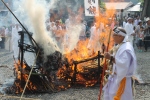
The ceremony ends with the head priest seeing off the mountain deities and spirits as they return to the mountain.
Again, the event is held only once every three years, so if you get the chance, be sure to check it out in 2015!
2 Comments | tags: お盆, 神楽, 祭, 験比べ, genkurabe, hashiramatsu, Japan, Japanese religion, kagura, matsuri, mountain religion, Obon, shinbutsu bunri, Shinto, Shugendo, state shinto, tengu, Togakushi, 天狗, 山岳信仰, 戸隠, 日本宗教, 柱松, 修験道 | posted in festivals, Japanese religions, memory, mountains, Shugendo, Togakushi, Uncategorized
Opening rituals done, and now begins the fun.
(Part 1 of this post can be found here.)
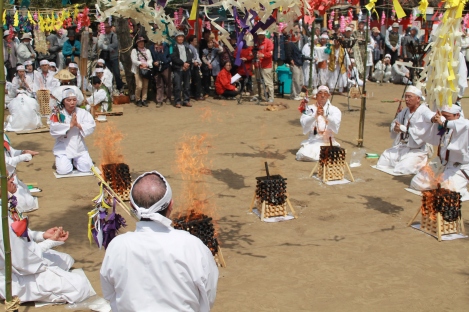
These five lit up goma precede the main fire of saito goma. The number of five represents a variety things in Esoteric Buddhism: five types of wisdom, five buddhas, or five luminous kings (明王). In this ritual, these deities are called down.
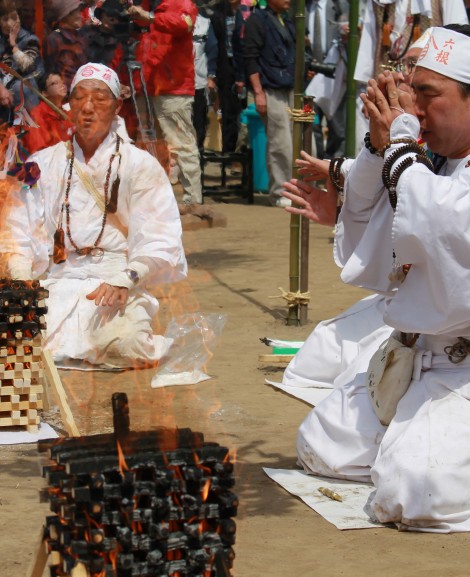
As the deities descend, the circle of practitioners chant and form hand mudra, both of which are meant to guard the deities against the scorching flames.

Now the main "saito goma" lights up. Characteristic of Shugendo, the saito goma is done outdoors with long spruce branches that billow out smoke. Formerly, it was conducted in the mountains. The name of this one - Ontake-san hon goma 御岳山本護摩 - suggests that it was traditionally held on Mt. Ontake itself.
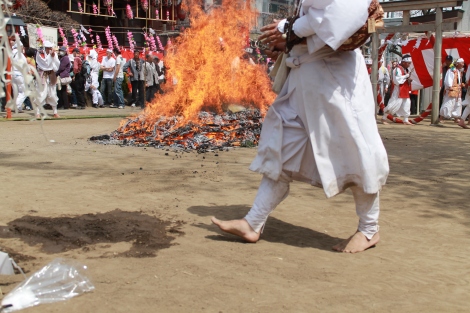
Note the bare feet, soon to be treading through the glowing coals of the goma.

Here is one of the first gyoja 行者 (practitioners) to walk across the coals in what is called hi-watari 火渡り, literally "fire crossing." The white salt you rub your feet in before the coals may lessen some of the heat, but not by much! This type of event was formerly practiced by shugen specialists after sustained periods of ascetic practice in the mountains. It was believed that these austerities in the mountains awarded them supernatural powers. They could then showcase these powers at events such as this one in order to attract lay followers (an important source of income).

Now anyone can cross the coals. Laity undergo it in order to gain this-worldly benefits (現世利益).

A young girl carried across by a specialist. Shortly after, others in line were discouraged from following suit, given the danger of falling.

Ha-watari 刃渡り, or "sword crossing," is less commonly practiced than the hi-watari. Sharp sword blades make up the rungs of the ladder, which leans against a wooden tower in the picture. Luckily, a regular ladder takes you down the other side.

Done properly, one comes out unscathed. That said, this woman's face shows the pain her feet are feeling.
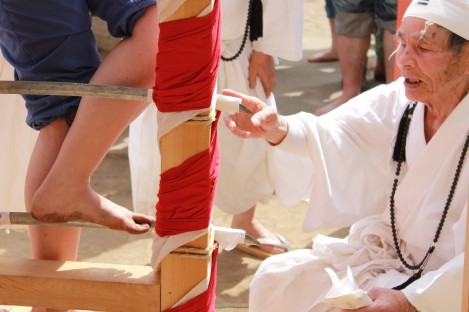
One of several prayer men attempting to insure safe passage.
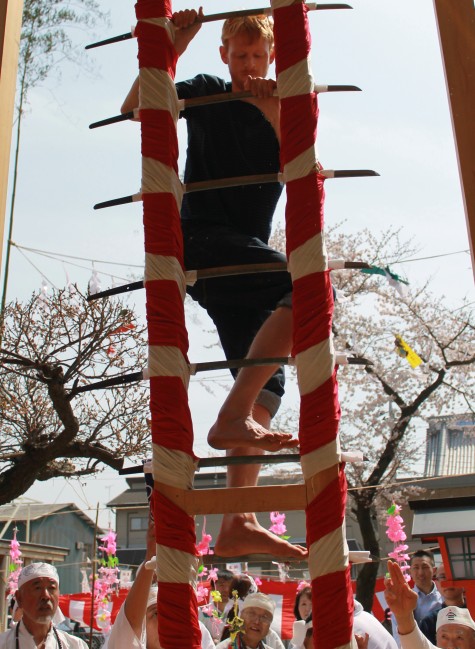
Leave a comment | tags: Buddhism, esoteric, 護摩、, Fukan, goma, Honjo, Japan, mikkyo, mountain religion, Ontake, ritual, saito goma, Shugendo, 御岳, 修験道 | posted in festivals, Japanese religions, Shugendo, Uncategorized
Last week, I took the two hour local train from Shinagawa up to Honjo, Saitama to check out an annual festival at the Fukan Reijo (literally, the “numinous site of Fukan”). Fukan was an eighteenth century ascetic who is said to have “opened up the mountain” (開闢) of Ontake. Before this, the mountain had guarded by local ascetics who only climbed it after long periods of seclusion. Through a sudden possession by the Great Avatar Zao (大権現座王) while on Ontake, Fukan was able to climb to the summit, thereby opening it to ordinary people afterwards.
Today, various confraternities (講) based mainly in the prefectures of Saitama and Gunma continue to gather at the Great Spring Festival and other smaller events to pray to Fukan for immediate benefits (現世利益) like the prevention or healing of disease, financial concerns, etc.
Numerous confraternities participate in the festival and each has a specific role to fulfill for the larger program of events. The rituals are largely based on shugen practices dating back to at least the Edo period (1600-1868). They comprise a mix of divination rituals, invitations to deities to enter the ritual space, and ‘extreme’ (in X Games parlance) events traditionally intended to showcase special powers acquired by the ascetics involved.
The festival will be divided into two blog posts: this one will cover the preparations and rituals leading up to the shugen event of saito goma 採燈護摩; and the next will cover the saito goma and events after. Also, special thanks to my advisor, Suzuki Masataka (Professor of Social Sciences at Keio Daigaku) for painstakingly answering questions I had regarding these pictures.

As the name suggests, the Great Spring Festival takes place on April 10th, just as the sakura are in full bloom. In the background is the Fukan Hall.

One of many altars set up for the festival. It consists of mochi (rice cakes), sake, flowers, fresh vegetables and fruit, prepared as offerings.

The events begin with a procession of all specialists to Fukan Hall. Leading the procession is the resident priest of Fukan Reijo.
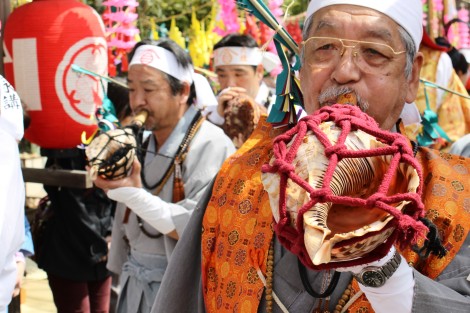
The procession is announced by the horagai 法螺貝, an instrument made mainly of a single large conch shell, typically used by practitioners of Shugendo.
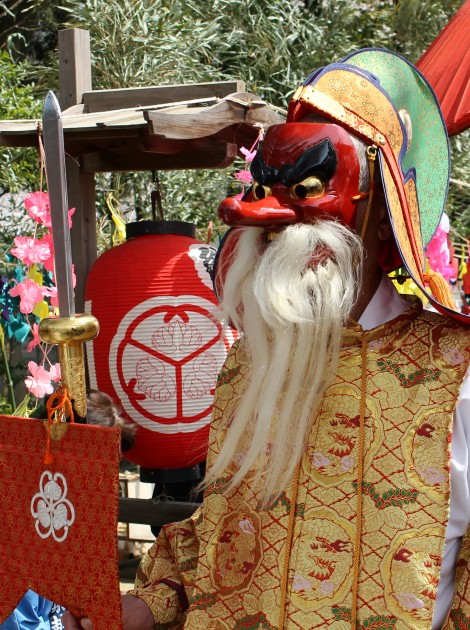
- Within the procession, a tengu wards off evil spirits with his sword.

Young children, dressed up in costume, are seen as occupying a liminal space between humans and the spirit world. Thus, their presence plays an important role as the practitioners will soon be hoping to engage with this realm.

A confraternity prepares one of many goma 護摩, which will later be lit in succession.
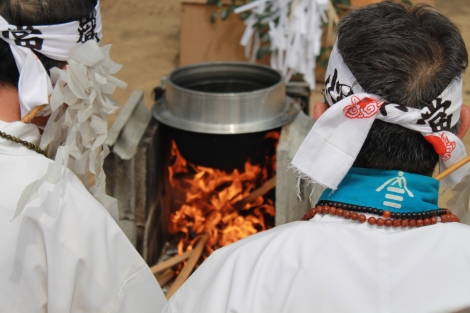
A confraternity boils water for the yudate 湯立て ritual, where water, once brought to a boil, is flung throughout the area.

The resident priest performs chants and mudra (hand gestures) before the saito goma, a major outdoor goma ritual specific to Shugendo.

Preparing a goma with incense on top. This goma will be the first to ignite, with its flame then carried to other gomas. Designated as the most powerful specialist here, he wields a shakujo 錫杖 staff in one hand and a vajra dagger in the other.

A shrine priest slices a sword through the air, ridding the space of evil spirits before the saito goma is lit.
1 Comment | tags: ascetics, early modern, 金剛, 護摩、, Fukan, goma, gongen, Honjo, mikkyo, mountain religion, Ontake, saito goma, Shugendo, Togakushi, vajra, 御岳, 権現, 修験道 | posted in festivals, Japanese religions, Shugendo, Uncategorized

